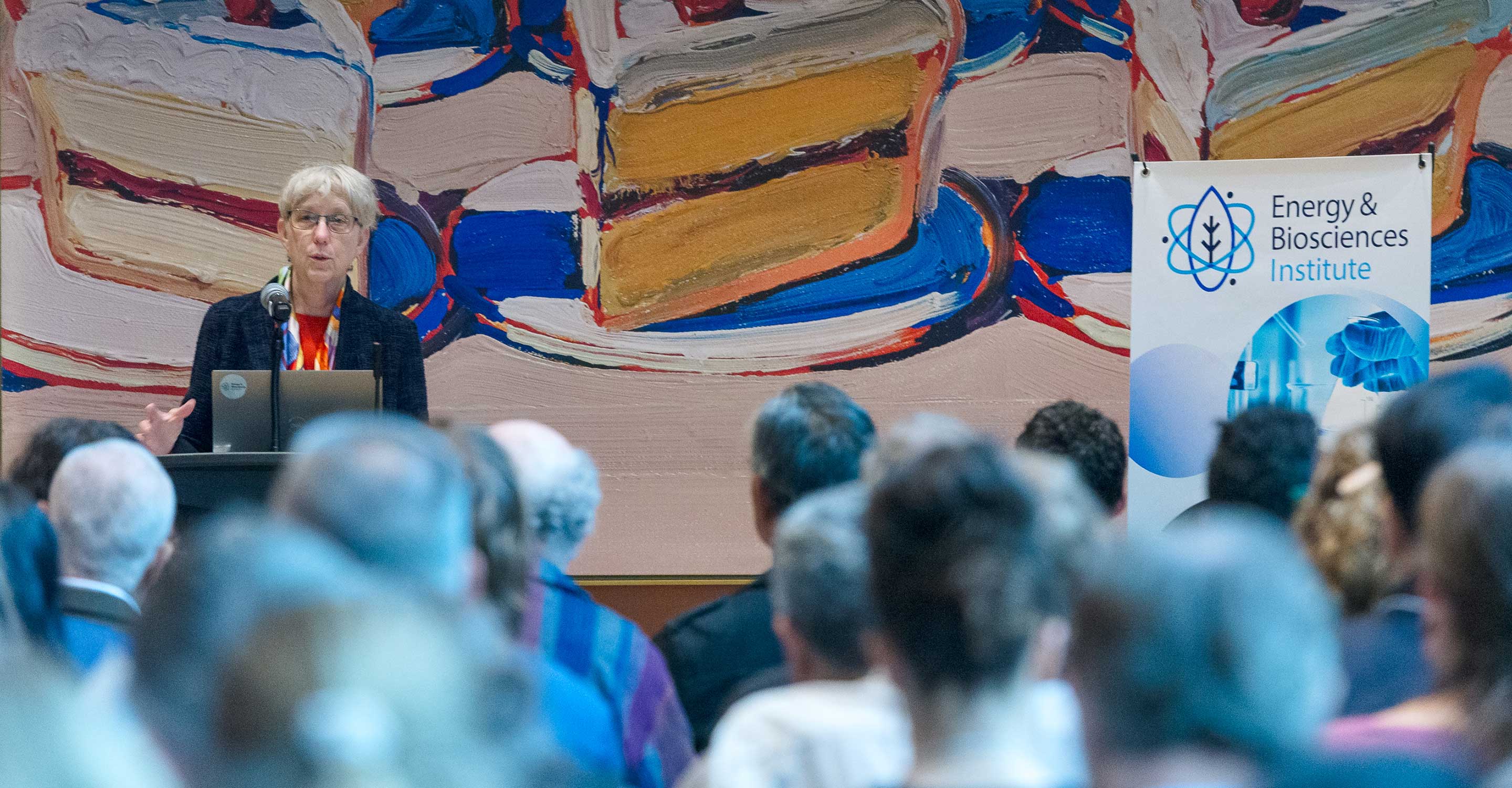Over 100 scientists, bioeconomists, government officials, Tribal members, corporate representatives, nonprofit leaders, and entrepreneurs from around the world gathered at UC Berkeley earlier this month for the Inaugural Workshop of the International Bioeconomy and Macroalgae Center (IBMC).

John Coates, co-director of the IBMC and director of the Energy & Biosciences Institute at UC Berkeley, speaking during the event. Photo by Mathew Burciaga.
Established in November 2024, the IBMC is working to facilitate the scientific advancement and responsible development of the seaweed bioeconomy. It is addressing the need for foundational knowledge, technological approaches, supply chain designs, policy frameworks, community engagement, and educational materials for businesses and consumers to build sustainable macroalgal-based bioeconomies. The IBMC currently involves nine countries, 15 research institutions, three marine field stations, and 43 collaborators—and is actively recruiting more.
The goal of the inaugural gathering was to foster an integrated approach to upscaling seaweed production, and to establish a network to advance knowledge, innovation, policy, management, workforce development, and local community engagement.
“Everyone in this room recognizes seaweed’s massive potential, but the field of seaweed research is very fragmented and siloed,” said Plant and Microbial Biology professor John Coates, who serves as co-director of the IBMC and director of the Energy & Biosciences Institute at UC Berkeley. “We’re excited to bring key players together to create community, and to learn about new technologies, challenges, and potential solutions. We’re also here to learn more about the marketplace and foster potential partnerships.”
During the event’s opening remarks, Vice Chancellor for Research Katherine Yelick applauded the interdisciplinarity of the event. “It’s often the case that we bring the researchers together—for example computational or data scientists and AI researchers with people in biological or marine sciences or sustainability—but it’s important to also have people that understand the economics and those who are focusing on impacts and directly helping the communities that will be most affected by the solutions that are being developed,” she said.

Vice Chancellor for Research Katherine Yelick delivered opening remarks. Photo by Mathew Burciaga.
Throughout the two-day event, sessions covered a range of topics including foundational research on macroalgae diversity and genomics; cultivation and harvesting innovations; processing techniques; Indigenous knowledge and traditions; workforce engagement; social equity; policy; circularity and waste management; and supply chain considerations.
Seaweed has been noted for its potential in many industries and to address many of society’s pressing challenges. It can be used as human or animal food, as a biostimulant that can replace harmful fertilizers, as a main ingredient in bioplastics to reduce plastic and microplastic waste, and in the pharmaceutical and cosmetics industries. It also offers huge promise for biofuels that reduce human dependence on fossil fuels, bioremediation to break down environmental pollutants, and carbon capture and storage to address the growing climate crisis.
During the day’s first keynote address, Rod Fujita of Ocean Innovations focused on some of the biggest challenges seaweed could tackle. “Seaweed is not a solution in search of a problem,” he said, emphasizing its potential to address the climate crisis through carbon sequestration, to restore damaged ecosystems, and to improve human welfare. Specifically related to carbon, Fujita mentioned seaweed’s potential as construction materials; plastics that could reduce microplastic pollution and greenhouse gas emissions (GHGs) associated with the use of petroleum and feedstocks; biostimulants to reduce GHGs associated with the production of fertilizer; and feed supplements to reduce GHG emissions from cattle.
He called for marketing to increase demand for seaweed products, improved governance to minimize adverse social and ecological impacts of expanded seaweed production, and planning to create a portfolio of farms optimized to deliver different benefits.
Throughout the two-day event participants heard from those with first hand knowledge farming seaweed, from others who conduct scientific research about the genomics of seaweed, from entrepreneurs and investors on scaling the seaweed bioeconomy, and from Tribal leaders who are incorporating knowledge and practice from elders who have upheld longstanding Indigenous traditions of harvesting and appreciating seaweed. Many presenters mentioned their ideas and successes while also acknowledging the remaining questions and challenges. The phrase “If anyone has ideas, please talk to me,” was often heard as presenters sought new ideas and connections from attendees.

Photos by Mathew Burciaga.
The workshop also included a screening of the short film Seaweed Stories, along with a panel discussion with some of the individuals featured in the film.
“The launch of the IBMC represents a pivotal moment in the transformation of macroalgae from a niche interest into a cornerstone of the sustainable bioeconomy. After 40 years of studying algae economics, I’ve never been more optimistic.” said David Zilberman, co-director of the IBMC and a distinguished professor in the Agricultural and Resource Economics Department. “With advances in genomics, biotechnology, and digital tools, and in the face of climate imperatives, this center brings together the knowledge, ambition, and collaboration needed to scale a $10–15 billion industry into one worth hundreds of billions.”
Future IBMC workshops are already scheduled annually through 2029, with the 2026 workshop being held at the Scottish Association for Marine Sciences, Oban Scotland.
